Laborer Dies After Being Run Over by a Backing Dump Truck During a Nighttime Paving Project - Virginia
NIOSH In-house FACE Report 2006-03
June 20 , 2007
Summary
On July 18, 2006, a 21-year-old male road construction worker (the victim) was fatally injured when a dump truck partially loaded with asphalt backed over him. The victim was a member of a road construction crew working at night on a state highway paving project. The dump truck driver was backing through the work zone, with the truck’s back up alarm sounding, toward the next section of roadway to be paved when the truck struck the victim. The paver and paving crew had already re-positioned to the next section of roadway to be paved. The dump truck driver was watching the driver’s side mirror as he was backing to align the truck with the re-positioned paver. As he was backing he did not see anyone behind the truck. He then saw something appear out from under the front of the truck, at which time he stopped the truck. Evidence suggests the victim had his back to the dump truck. The victim had not been assigned tasks within the workzone, but may have been shoveling spilled asphalt. Emergency medical services (EMS) personnel were called and arrived on the scene to find the victim deceased.
NIOSH investigators concluded that, to help prevent similar occurrences, employers should:
- ensure that backing procedures are in place for the use of mobile construction vehicles, and use spotters for assistance when backing trucks and equipment in the work zone
- ensure that all workers, including sub-contractors, receive work zone safety training and are familiar with standard operating procedures before beginning work or being allowed entry into the work zone
- ensure that during planning phases of roadway construction, procedures are developed which minimize backing distances of vehicles and equipment through the work zone
- ensure that the work zone is properly illuminated
- consider installing after market electronic signaling devices or sensors on construction vehicles to help monitor the presence of workers on foot within blind areas
- implement a “buddy system” for employees working around construction equipment
- consider having paving machine(s) and crew(s) remain in a safe area at the paving location until clean up work is complete and all workers are in the clear and accounted for
Introduction
On July 18, 2006, a 21-year-old male road construction worker (the victim) was fatally injured when a dump truck partially loaded with asphalt backed over him. On July 24, 2006, the National Institute for Occupational Safety and Health (NIOSH), Division of Safety Research (DSR) was notified of the incident by the Virginia Department of Labor and Industry, Occupational Safety and Health Administration (VOSH). On August 9-10, 2006, DSR investigators conducted an investigation of the incident. The case was reviewed with the paving contractor’s Safety Director; the Virginia Department of Transportation (VDOT), Office of Employee Safety and Health; and, the VOSH compliance officer assigned to the case. None of the coworkers or supervisors who were working on the night of the incident were available to be interviewed. A copy of the state police report was reviewed. VDOT provided photographs taken the day after the incident. Photographs of the site were also taken by NIOSH investigators.
Employer
The victim’s employer, a paving corporation, employed approximately 140 employees during peak season, and had approximately 85 employees working throughout the year. The company had been in operation since the mid-1940s. The company worked a variety of state contracted and commercial projects. A typical highway paving crew consisted of approximately 15 crew members. The company operated 30 dump trucks and contracted 30 independently owned trucks. The night of the incident the employer was working a state Department of Transportation project with one area supervisor and one project supervisor.
Victim
The victim was 21 years of age, and had been employed for 3 months as a general laborer with the paving company. His primary responsibility was that of a van driver to transport workers who did not possess driver’s licenses to and from the job site. When not driving a van, he would sometimes perform duties such as flagger or laborer.
Equipment
The project was being completed with one paver, two rollers, a sign truck, a distributor truck, and 15 dump trucks. All dump trucks hauling asphalt on the project were owned and operated by independent contractors. The truck involved in this incident was a 2005 model year dual axle dump truck measuring 33’4” in length and 8’ 7” in width. The truck was inspected by VOSH and found to have properly functioning lights and back up alarm.
Safety program and training
The paving contractor employed a full-time Safety Director who was not on site at the time of the incident. Site supervisors are responsible for site safety, and safety problems are reported to the company Safety Director, as necessary. The company had a comprehensive written safety and training program, but no site specific plan was available for review.
Classroom training and informal bi-monthly “toolbox” safety talks were provided to company employees. There was no evidence found that the victim had received any type of internal work zone safety training prior to the incident. No training program was targeted towards sub-contractors. No safety procedures were specified in the contract language other than the use of traffic signage specified by VDOT requirements.
This was the employer’s second fatal back over incident; the prior fatality occurred in 1993.
Investigation
The employer had been contracted by VDOT to pave an urban stretch of 4 lane divided state highway. Paving of the highway travel lanes had been completed, and before lane line painting could begin, the paving of the turn lanes approaching the intersections needed to be completed. An independent trucking company had been contracted to assist with hauling asphalt from the asphalt plant to the project site.
Work on the turn lanes began on the evening of July 18, 2006, at approximately 8:00 p.m., with closure of the inside westbound lane adjacent to the concrete median and the set up of the work zone. Traffic cones were used to close the westbound lane and channel traffic past the work zone (Diagram 1). The project area was described as being very dark with the absence of street lights along the work zone. Parking area lighting from adjacent business establishments provided the only ambient lighting in the project area.
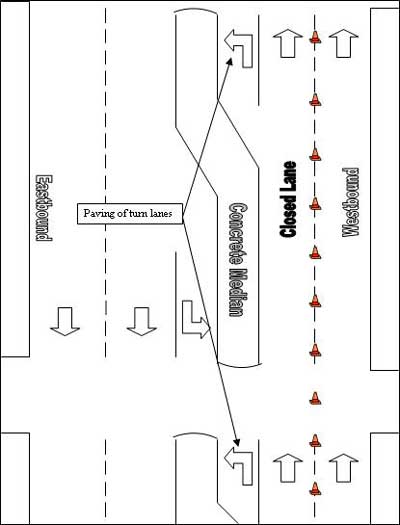 |
|
Diagram 1: Overhead view of workzone
|
After paving a turn lane, operators of the paver and dump truck loaded with asphalt would proceed to the next turn lane. The paving company’s Safety Director stated to investigators that the employer’s normal standard operating procedure (SOP) briefed verbally to drivers was for trucks not to back through the intersections. The stated SOP was for the trucks to perform a u-turn and enter the east bound lane and travel back past the paver before turning back into the west bound lane, approaching the paver from the rear while driving forward (Diagram 2). The truck would then pull forward in front of the paver, thereby minimizing the backing distance to the paver. Spotters were located only at the paving machine to assist the driver in aligning the truck with the paver. No written SOP for trucks backing through the work zone was provided to investigators.
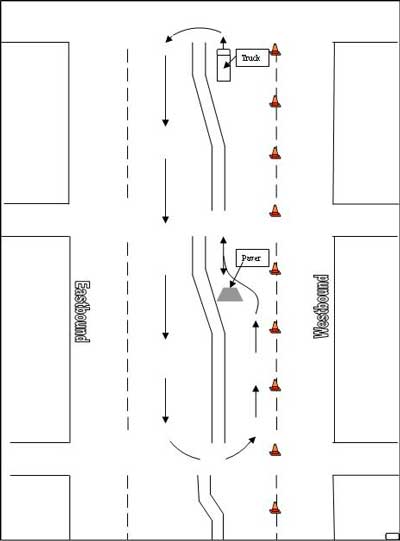 |
|
Diagram 2: Depiction of truck approaching paver in accordance with stated SOP
|
At the time of the incident, the paving crew had just finished a turn lane and had backed the paver through the closed lane to the next turn lane which was located at an intersection approximately 150 yards east of the previous turn lane. The paving crew had walked with the paving equipment to the next intersection. The victim had not walked with the rest of the crew, but had remained further back in the closed lane (Photo 1). None of the work crew or the on site supervisor knew why the victim had not accompanied the rest of the work crew to the paver. According to the site supervisor he was not assigned any tasks in the work zone.
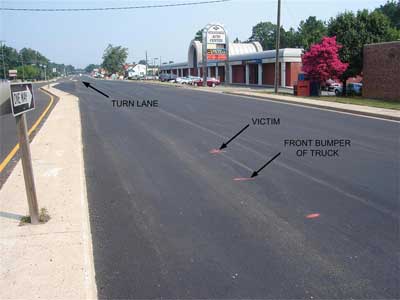 |
|
Photo 1. View facing west towards turn lane paved just prior to incident. Photo illustrates the location of the victim after being struck in relation to the truck after coming to rest in the inside west bound lane .
(photo courtesy of VDOT) |
As the driver was backing the dump truck through the work zone (backing east through the closed westbound lane) he was looking through his driver’s side mirror to aide in aligning the truck with the paver while approaching the intersection. The driver stated he did not see anyone behind the truck. As he was backing the truck he felt a bump and noticed something appear out from under the front of the truck (Diagram 3). The driver stopped and got out of the truck. A VDOT Consultant Inspector, who was at the project site, was signaled that there was a problem. The inspector looked up and saw what appeared to be a high visibility traffic vest in the road. EMS personnel and the Virginia State Police were notified at approximately 11:00 p.m. The victim was pronounced dead at the scene.
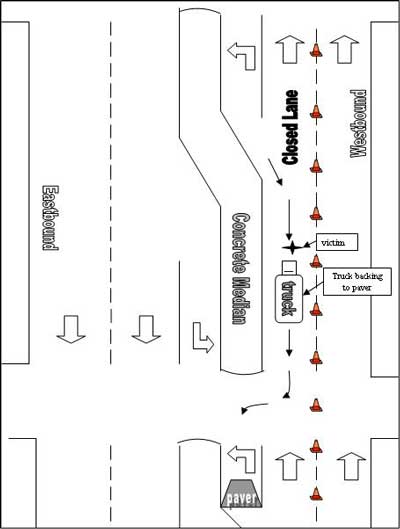 |
|
Diagram 3: Truck backing through westbound lane towards paver
|
Evidence suggests the victim had his back to the truck when he was struck. He was struck by the rear right side of the truck and the right side tires passed over him. The truck was approximately 100 feet from the intersection it was approaching when it struck the victim (Photo 2). The victim was wearing a high visibility vest and hard hat. A shovel normally used to shovel asphalt spill back onto the roadway was beside the victim. Although the victim had not been assigned any tasks within the work zone, he may have been shoveling spilled asphalt at the time he was struck by the truck. The paving company’s safety director stated the back up alarm and lights were functional on the truck. Other than flood lights on the paving equipment and working lights on the trucks, no supplemental lighting sources were present at the site. The work crew had been provided with hard hat lights.
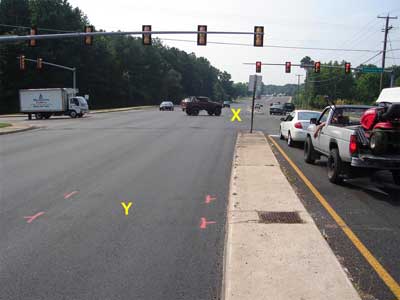
|
|
Photo 2. View facing east towards intersection and turn lane where paver was being re-positioned. Truck was backing towards the turn lane denoted by “X”. The “Y” denotes resting position of rear truck tires after striking victim . |
Back to Top
Cause of Death
The medical examiner’s office reported that the cause of death was multiple crushing trauma.
Recommendations/Discussion
Recommendation #1: Employers should ensure that backing procedures are in place for the use of mobile construction vehicles, and use spotters for assistance when backing trucks and equipment in the work zone.
Discussion: The roadway construction work zone can be a very confined and congested space. When a truck backs up in a busy work zone, there is an increased risk of collision with construction vehicles and equipment, or injury to workers on foot and equipment operators within the work zone. Truck drivers and other equipment operators must be informed about, and then adhere to, established traffic routes required by the prime contractor for travel through the work zone and they need to be observant and aware of activities, vehicles, and workers that may interfere with their ability to safely complete their task. Spotters on foot can help manage trucks and other construction equipment backing up in the work zone. The spotter provides the “vision” that the driver does not have when backing up and helps reduce “blind areas.” Policies should be developed that require spotters to wear high visibility apparel, and should prohibit backing until a clear and understandable signal is received from a spotter that it is safe to begin backing. 1 Also, the importance of using proper backing procedures, to include the use of both side mirrors when backing, should be continually stressed during safety briefings and before the beginning of each work shift.
Recommendation #2: Ensure that all workers, including sub-contractors, receive work zone safety training and are familiar with standard operating procedures before beginning work or being allowed entry into the work zone.
Discussion: The victim’s primary duty was to provide transportation for unlicensed employees to and from the job site. Although his primary duty was a van driver, he would occasionally perform duties such as flagger or shovelman. However, according to the victim’s on site supervisor, he was not assigned any duties in the work zone at the time of the incident. No reason could be given as to why he was there. There was no evidence to suggest the victim had received prior training on work zone safety or standard operating procedures.
Safety training increases a worker’s awareness and ability to recognize potential hazards in the work zone, including being aware of driver “blind areas” around construction vehicles. Since different project sites are likely to require different safety procedures, it is imperative that all workers are knowledgeable of, and implement, project specific work zone safety procedures. To ensure all workers and equipment operators are aware of the established safety procedures, and are capable of identifying work zone safety hazards, all sub-contractors should also be included in project specific safety training and a plan developed to orient sub-contractors to the current procedures. Language should be included in the contract that mandates subcontractors to participate in site-specific safety orientation. Failure on the part of any one worker or contractor to understand or practice established safety procedures can jeopardize the safety of themselves and others. Workers should not be allowed into the work zone until they have received appropriate training on work zone safety. Safety policies and standard operating procedures should be strictly enforced by site supervisors.
The stated standard operating procedure was for trucks not to back through the intersections. Because investigators were unable to talk to the sub-contractor it is not clear if the truck driver was aware of the established safety procedures.
Recommendation #3: Employers should ensure that during planning phases of roadway construction, procedures are developed which minimize backing of vehicles and equipment through the work zone.
Discussion: In this incident, paving operations were being conducted where the paving equipment and trucks needed to be repositioned from one intersection to another to pave turn lanes. At the time of the incident, the truck driver was backing approximately 150 yards to reposition with the paver at the next intersection to be paved. When planning roadway construction projects, employers should develop procedures which minimize backing distances to the greatest extent possible. One potential tool to help in developing these procedures is an Internal Traffic Control Plan (ITCP). The ITCP assists in coordinating the movement and flow of construction vehicles, equipment, and workers on foot operating in the work zone. Guidance for developing an ITCP has recently been published.2 Additional safety information and recommendations for protecting roadway construction workers can be obtained from the NIOSH document entitled “Building Safer Work Zones: Measures to Prevent Worker Injuries from Vehicles and Equipment.” 1
Recommendation #4: Employers should ensure that the work zone is properly illuminated.
Discussion: Although illumination measurements were not recorded, the work zone was reported to be very dark. Inadequate lighting of work zones raises concerns about the ability of workers, equipment and truck drivers to operate safely within the work zone. The Occupational Safety and Health Administration (OSHA) regulations require a minimum illumination of construction areas.3 The OSHA required minimum illumination standard for general construction areas is 5 foot-candles. However, the National Cooperative Highway Research Program recommends a minimum illumination of 10 foot-candles for paving operations. Detailed information on work zone lighting can be also obtained from the National Cooperative Highway Research Program’s document entitled “Illumination Guidelines for Nighttime Highway Work.” 4
Recommendation #5: Employers should consider installing after market electronic signaling devices or sensors on construction vehicles to help monitor the presence of workers on foot within blind areas..
Discussion:Rear-view cameras and specialized sensors that are based on radar, sonar, and infrared technology are available to assist in monitoring vehicle blind spots. Although these devices have limitations, initial studies are promising.5 Rear mounted cameras provide a view of the blind areas on a monitor mounted inside the cab. Sensor systems provide an alarm in the cab when a person or object is detected within a certain distance of the rear of the vehicle. A combination of a camera and a sensor system may offer the best protection. A sensor alarm would alert a driver to the presence of an object behind the vehicle and the driver could look at the video monitor in the cab to verify the presence of an object in the blind area.
Recommendation #6: Employers should implement a “buddy system” for employees working around construction equipment.
Discussion: The victim in this incident was alone without anyone having knowledge as to why, or what, he was doing in the area of the work zone where the incident occurred. When a worker is focused on a task it may be difficult for the worker to recognize or react to moving equipment. A buddy system, where coworkers are assigned to spot one another, would allow a worker to focus on a task while another coworker watches for the movement of equipment and other hazardous situations. Such a system would also improve the accountability of the whereabouts of each worker during the work shift, ensuring the safety of each individual.
Recommendation #7: Employers should consider having paving machine(s) and crew(s) remain in a safe area at the paving location until hand work is complete and all workers are in the clear and accounted for.
Discussion: In this incident, the paving crew would pave a turn lane then proceed by re-positioning the equipment to the next lane. The victim did not stay with the rest of the crew while the paver was re-positioned. Though reportedly not assigned a task, the victim was found with a shovel and may have been cleaning up spilled asphalt along the curb or the joint between the travel lane and the turn lane. In situations where the paver has to be re-positioned, the paver should remain nearby until all workers involved with hand work complete their tasks. This would prevent having to leave workers behind to perform clean up tasks where they may be exposed to hazards posed by moving equipment and trucks.
References
- Pratt SG, Fosbroke DE, Marsh SM [2001]. Building Safer Highway Work Zones: Measures to Prevent Worker Injuries from Vehicles and Equipment. Cincinnati, OH: U.S. Department of Health and Human Services, Centers for Disease Control and Prevention, National Institute for Occupational Safety and Health (Pub. No. 2001-128).
- Graham, JL, Burch, R (2006) Internal Traffic Control Plans – Worker Safety Planning Tool. Transportation Research Board (TRB) 85th Annual Meeting. Available at: http://trb.metapress.com/content/p257m2137r846777/external icon
- Code of Federal Regulations (2005). 29 CFR 1926.56 (a). Illumination. Washington, DC: U.S. Printing Office, Office of the Federal Register.
- NCHRP [2003]. Illumination Guidelines for Nighttime Highway Work. National Cooperative Highway Research Program (NCHRP), Report 498. Available at: http://onlinepubs.trb.org/onlinepubs/nchrp/nchrp_rpt_498.pdfpdf iconexternal icon
- Ruff, T. Evaluation of Systems to Monitor Blind Areas Behind Trucks Used in Road Construction and Maintenance: Phase 1. Cincinnati, OH: U.S. Department of Health and Human Services, Centers for Disease Control and Prevention, National Institute for Occupational Safety and Health. NIOSH Report of Investigation 9660 (DHHS Publication No. 2003-113), 2003, 16 pp.
Investigator Information
This investigation was conducted by Virgil Casini, Senior Investigator, David Fosbroke, Statistician and Philip Kemp, Guest Researcher, Fatality Investigations Team, Surveillance and Field Investigations Branch, Division of Safety Research. This report was authored by Philip Kemp.
